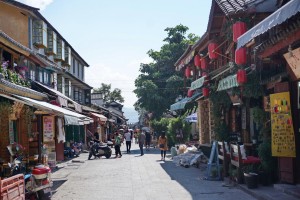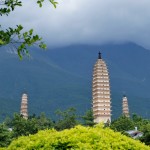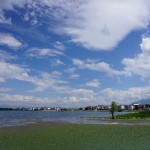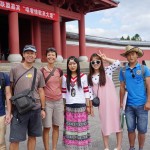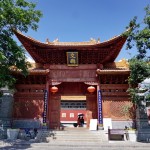The centre of Bai culture, the capital of the autonomous Region Dali, the perfect location according Feng shui, the town between the 4000m range CangShan and lake Erhai, place of one of the most improtant Han buddhist Pagoda, former Mekka oft he traditional western joint smoking backpackers, present magnat of masses of Chinese tourists… There are many attributes to Dali.
The new town, is the biggest, most modern Chinese City we had passed so far. We continued 16km north along the western shore of lake Erhai to the old town. The old town is still having an intact wall around itself and is famous for its quite intact face of traditional Bai architecture. The old town is the centre of tourism with hundreds of hotels, restaurants (even a McDonalds) and shops trading lokal products. There are many local specialties: greenstone jewlery, artwork out of marmor stone, silk skarfs, yak chees, yoghurt, rose cookies, nougat. The lanes, free of cars, are picturesque and get more and more packed with all sorts of poeple towards the evening. The main group are Chinese tourists, whose number though will further increase dramatically in July when the holiday season starts. Since we are in China we had little to no contact to tourism especially to western travellers. Dali for us was a change. We enjoyed the infrastructure, the possibility to get a yoghurt-fruit-muesli and bread for breakfast, the chance to chose from new dishes from a menu written in English and we loved to meet other travelers speaking more than Chinese.
From lunchtime onwards the roads started to become alive and they filled up after dark, when the volume from the partying got louder and louder. But we didn’t need to participate in this. We had a wonderful quiet room, a perfect place for our rest. We experienced the local people as positive as we had got to know all the Chinese in China so far. The Chinese tourist, seemed to be of a different kind. They are rich, loud and seem arrogant. Money, cars and glamor count. Environment and other people are irrelevant. We didn’t get into contact with this part of the population.
Between the Chinese we did find a few western faces. Only very few of them were travelling through like we do.Most of the few «westerners» in Dali explained, that they are living here. We had some very interesting hours talking with them. We were curious to hear, what had made them leave their countries and fascinated to get do know about their dreams they followed in their new chosen home. Some of them might one day look for the way back to their origin.
Our observation, that the reputation of China and especially of the Chinese is worse the reality, we found confirmed in these conversations. Once here the immigrants didn’t feel confined by the controll of the state. In contrary, they found a freedom to organise their lives as they had dreamed but had been unable to to realise back home. They do not close their eyes before the doing of the government, but in Dali they found themselves far enough away from its controll in Beijing. Within the strict network of regulations there is plenty of freedom. Also in Dali the climat is very favourable. You find almost our distinct 4 seasons. To live in one of the Megacities with the dschungel of skyscrapers, smog and the competition caused by the high population density would not be an option for the immigrants though.

